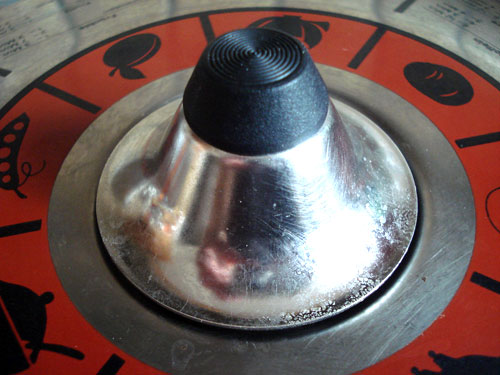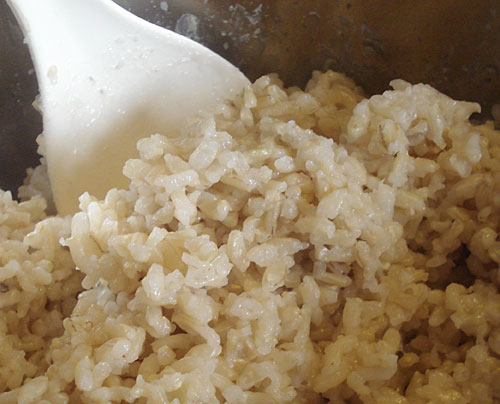(This is the web elf. This article is one of the articles Maki instructed to post while she's on the disabled list.)
Image may be NSFW.
Clik here to view.
If there's a kitchen appliance that needs a serious image makeover, it's the pressure cooker. Old myths abound about how dangerous and scary it is to use. Horror tales linger from the olden days of exploding lids and contents getting stuck on the ceiling. I'm not even sure if those stories are acrophyal, but I do admit that I sort of believed them too.
But then I inherited a 20 plus year old pressure cooker a couple of years ago. It belonged to Martha, Max's mom, and she used it all the time until she wasn't able to cook any more. It seems that pressure cookers are as ubiquitous in Swiss kitchens as rice cookers are in Japanese ones. (Incidentally, pressure cookers are getting more and more popular in Japan too.) Martha used to use hers for everything from soups to cooking potatoes. After my initial fears, I've grown to absolutely love the cooker. And yes, even though it's so old, after replacing the rubber gasket it works as good as new. (It really pays to buy from a reliable company that you can get replacement parts from on something they sold so long ago! For what it's worth, it's a Kuhn Rikon Duromatic. They still make them, with rather sleeker designs. If this old one ever breaks down I'm getting another Duromatic for sure.)
Reasons for owning a pressure cooker in the 21st century
- It's fast and efficient at what it does (No wonder it's so popular in efficiency-minded Switzerland.)
- It's energy efficient, since it cooks things faster than conventional methods.
- It's a multi-tasker. Not only does it pressure-cook various things, a good quality pressure cooker pot has a nice heavy bottom which lends the pot itself to be used as a general cooking pot.
- It's perfect for cooking whole grains and pulses (beans and such), which we should be eating more of. More about this below.
- It's sort of high-tech, but it doesn't do anything weird to the food, like apply microwaves to it or zap it with infrared rays.
- There is a tiny element of danger, which focuses your attention and eliminates boredom in the kitchen. (Hey, there's more danger in using a very sharp knife.)
- It's a geeky piece of kit that makes you feel like you're conducting a science experiment.
The rules you must follow for using a pressure cooker
- RTFM (Read The eh, Manual). Cooker model operation varies according to the model you have, so generic instructions shouldn't be followed. Read the manual through and be sure you know how the pressure builds, and how to de-pressurize it.
- Buy a good quality cooker, that you can trust not to break in operation. As my 20-plus year old cooker shows, a good quality pressure cooker will last for ages.
- Don't ever try to force a pressurized cooker open. I suspect that a lot of the exploding lid horror stories originated from stupid people who didn't RTFM!
Every vegetarian should have one of these
As I stated above, a pressure cooker is the perfect appliance for cooking whole grains and pulses. So if you are a vegetarian or vegan who relies on these for your protein, or just someone looking to incorporate more vegetable proteins into your diet, a pressure cooker will be the hardest working appliance in your kitchen.
For example, I periodically cook up a potful of chickpeas and make a vat of hummus, which is then portioned and frozen. If I cooked them conventionally, it would take about 3 hours (depending on how long they'd soaked) for them to be soft enough. In a pressure cooker, chickpeas that have been soaked overnight take only 20 minutes! Even unsoaked chickpeas take only about 30 minutes. And they turn out totally soft, all the way through - no stray hard peas like I occasionally get with conventional boiling.
I also cook soy beans sometimes, to eat just plain boiled, or turned into natto. Soy beans take quite a long time to cook conventionally, longer than regular beans. In the pressure cooker, overnight-soaked beans only take 20 minutes or less. (Boiled soy beans have a very nice flavor, and the cooking liquid can be used as a vegetarian stock.)
Quinoa only takes 5 minutes! Lentils, maybe 10 minutes. And so on and on.
Cooking brown rice in a pressure cooker
Image may be NSFW.
Clik here to view.
Brown rice cooked in a pressure cooker turns out quite glutinous and 'sticky' in a good way. It's not necessarily faster than long-soaking them and cooking in a rice cooker, but I rather prefer the texture of the rice when it's been pressure cooked.
Put 2 cups of rinsed brown rice in a pressure cooker and add 2.5 cups of water and a pinch of salt. Let soak for an hour, then close the lid and bring up to pressure. Lower the heat and cook for about 25 minutes. Take off the heat and either allow the pressure to come down naturally or by releasing the pressure quickly, following the instructions in your cooker's manual.
Brown rice cooked this way is the perfect texture for making brown rice onigiri successfully.
What about meat?
Most pressure cooker cookbooks put a lot of focus on cooking meat. A pressure cooker does tenderize meat as it cooks, making it all soft, which can be a good thing. But that isn't necessarily a good thing. For instance, I pressure-cooked a chicken once, with the intention of making a chicken salad. The chicken was moist and cooked in about 30 minutes as opposed to the hour or more it takes me to poach chicken conventionally. But the texture of the meat was all wrong - it was mushy and soft, like a cheap canned chicken - not what I wanted at all. (The pressure also turned the bones into mush, so there were tiny splinters in the meat when it was shredded up that had to be taken out carefully.)
I think that the pressure cooker is best used on those tough, cheap cuts of beef and things, with enough fat and gelatinous bits in it. A combination of pressurized cooking and conventional simmering works very well with things like soups and stews. Max has a great recipe for a curried beef and potato soup that I will get him to post here eventually.
That being said though, I use my pressure cooker mainly for vegetarian cooking. (I rather believe that the plethora of mediocre-tasting meat dishes from a pressure cooker that pressure cooker cookbooks have traditionally focused on have contributed to it having a rather fuddy-duddy image.)
And in conclusion...
I hope that I've at least piqued your interest in pressure cookers, especially you vegetarians out there! Don't be afraid of it - it really is a great hard working appliance.
Type: feature Filed under: equipment and supplies